What Exactly Are Today’s Biggest Risks? Our Survey Reveals What Carriers Are Watching Most

Considering everything from market capacity to particularly difficult exposures, the results reveal an industry that is still managing the challenges posed by the talent gap, supply chain shortages and rising inflation, but it has the robust capacity and alternative risk solutions to manage the evolving perils their insureds face.
Captives and parametrics in particular are gaining traction as the industry adjusts its appetite for commercial property risks after years of repeated natural catastrophe events.
Inflation and rising interest rates, too, caught the eye of survey participants, especially when it comes to their effect on the cost to rebuild a property after a storm.
In total, 163 carrier executives participated in the survey. Here are some key findings.
Talent Shortages Remain a Major — but Manageable — Hurdle
The survey found that attracting and retaining talent remains a challenge for carriers, but many organizations feel the issue is manageable.
Just over 57% of respondents said the talent gap is impacting their organization but the effects are manageable. Another 14% said the gap has had a dramatic effect on their organization, and about another 20% of carriers said it’s not a significant issue.
The insurance industry — which struggled with retirements and a lack of interest from young workers even before the Great Resignation began — may be more well equipped than other sectors to combat staffing shortages.
Many carriers started at the college level, educating students about career opportunities within the industry and building internship programs that helped funnel students into underwriting careers. Now, 35 states have insurance-related programs at their two- or four-year higher education institutions.

Lawyer Davis, vice president of E&S personal lines, Nationwide
“It allows them to get a sense of our culture and see who we are as an organization, not to mention how strong and stable our company is,” said Lawyer Davis, vice president, E&S personal lines with Nationwide.
“The internship program is vital to ensuring we have a strong talent pipeline, and it’s a viable option for beginning a career with Nationwide.”
In addition to recruiting new employees into the insurance workforce, some carriers are providing current employees with more training opportunities.
Eighty percent of workers across industries don’t think their current employers offer enough training, per reporting from the Wharton School of Business. It also found that employees with professional development benefits have a 34% higher retention rate.
Within the insurance industry, our survey found that over 41% of carriers said they were investing substantially more in training programs than they were five years ago. Support for earning designations or providing educational tracks that help workers rise into positions with more responsibility can be a valuable tool in tackling insurer talent shortages.
Other strategies, like offering remote work benefits and competitive compensation, have also been successful, Davis said.
“We allow our associates several work location options, ranging from full-time work-from-home to 100% work from the office and many options in between,” Davis said. “We’ve been very successful at attracting talent.”
Supporting Insureds as They Navigate New Challenges
Talent shortages aren’t the only obstacle carriers are facing.
In today’s fast-paced world, exposures are constantly shifting and insurers must remain abreast of the risks their insureds are most concerned about.
Carriers named property, supply chain and cyber perils as the three risks that are most difficult for insureds to manage and transfer. More than 28% of respondents listed property as the most challenging exposure, 26% named supply chain and 17% cyber.
Sometimes, these challenges bleed into one another.
Supply chain shortages have led to rampant price inflation for a wide array of products, including many that are used in construction. That’s made calculating accurate values in property insurance a challenge over the past few years, though just over 56% of survey respondents said that, while the issue remains, it is improving.
“As a country, over the past several years, we’ve felt the effects of inflation in most if not all facets of our life,” Davis said.
“This has made us as an organization much more deliberative and diligent when it comes to pricing, thinking about our terms and conditions and underwriting guidelines.”
“There continues to be good awareness around insuring to value, with broker partners and insureds working closely with carriers to ensure valuation is addressed,” added Michael LaRocca, head of property and specialty for North America with Swiss Re Corporate Solutions.
Expanding Capacity and Alternative Risk Transfer Solutions
Despite the continuing challenges with cyber, property and supply chain exposures, commercial insurers reported seeing significant new capacity enter the market for a number of challenging lines.
Over 58% of respondents said that they see significant new capacity in property markets, which have struggled with rate increases in recent years. Businesses faced cyber insurance rate increases ranging from 20% to 100% in 2021, but now 45% of the carriers we surveyed said they saw new capacity entering the market.
Though a less difficult line in recent years, general liability is also seeing new capacity: 72% of survey respondents said they’re seeing growth in the line: “Every organization wants general liability business,” Davis said.
In lines where pricing remains a challenge, insureds are turning to captives, parametrics and other alternative risk transfer solutions. Over 15% of survey respondents said they were underwriting more captives business compared to 2020, and 24% said parametrics are becoming more prevalent in their book of business.
Captives have long been a solution insureds have turned to as a refuge from difficult market conditions.
“Captive insurance companies increase in popularity in a challenging or hard insurance market like we have experienced since 2020,” LaRocca said.
“Corporations are better able to leverage the insurance market with an alternative to retain and finance risk efficiently. In hard insurance markets, pricing, terms and conditions in primary and buffer layers excess of deductibles often become inefficient, so corporations need alternatives.”
On the parametrics side, carriers say insureds appreciate the flexibility of these kinds of policies, their quick payouts and their ability to offer coverage for exposures like contingent business interruption, where traditional markets struggle to offer coverage options.
Parametrics pay out based on a system where if a particular event occurs, the policy pays a specific amount. So if wind speeds in their area reach a certain level, an insured will receive a predetermined payment without waiting for an adjusting period.
LaRocca said that, since 2020, it has taken Swiss Re an average of 14 days to pay insureds for a parametric claim.
“These features make the claims process far less opaque when compared with traditional insurance,” he said. “The speed of payout is fast — most parametric policy wordings require that the claim is settled within 30 days of the event, but oftentimes this is much quicker.” &










